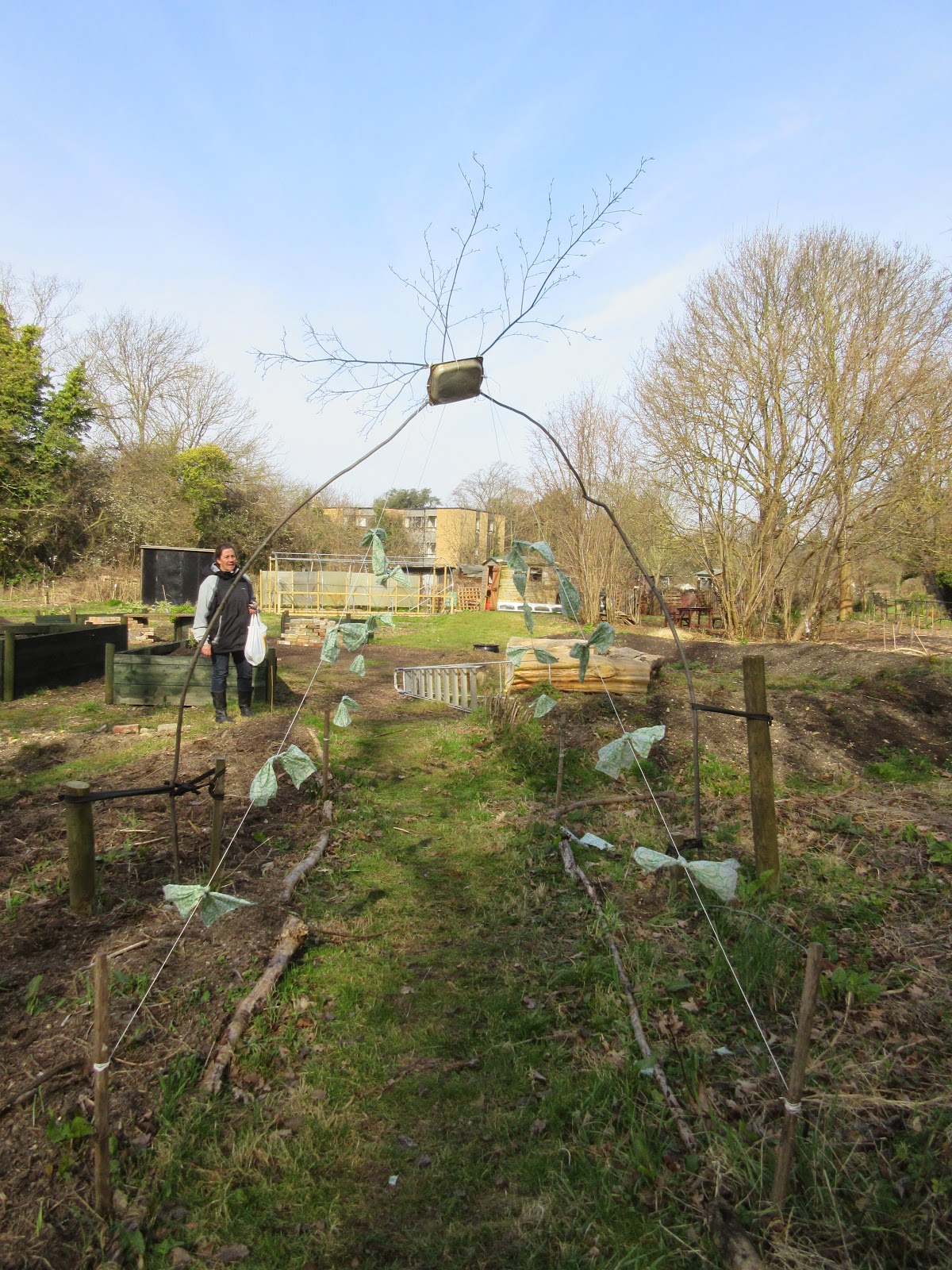This is the official blog of the award-winning Empty Common Community Garden, which is in Cambridge, UK. It is open to all and is very inclusive. It is based on the principles of permaculture and we grow food and flowers to encourage wildlife (bees, insects, etc). We use no pesticides.
Tuesday 31 March 2015
Inosculation at Empty Common Community Garden
Ino what? You might ask. In the photos above, Susanna held two tree trunks together and tied them to an aluminium baking tray, which had holes drilled into it. She then sliced a little off the trunks where they joined so their cambia were in contact and taped the whole lot tight to keep out the air and help stop the joining tissues from moving against each other.
The pretty green bows made with plastic bags stop the whole tree structure waving around too much. If you want to have a go at inosculation, here is an article with a few more examples... click here to read it.
The blog (not the garden!) is taking a holiday break so we will be back the Sunday after next. Happy Easter everybody!
Monday 23 March 2015
Polytunnel party!
On Sunday we celebrated the erection of the polytunnel. Thank you to the building team for such a sterling effort! Just click on the pictures to enlarge them.
If you like what you see, please join us! Read the first post of this blog to find out where we are and how to join. It's free, fun and we are very inclusive.
 |
| The new addition to the garden, next to the new shed and the old shed peeking behind |
 |
| Our sharing box, facing a busy footpath |
 |
| A view of the Empty Common Community Garden from the public footpath |
 |
| Another view, including some of our raised beds |
 |
| One of our young members, busy planting |
 |
| Getting our party started, wood-burning kettle for our tea outside, of course! |
Monday 16 March 2015
More gardening jobs for March: mulching
 |
| Mulching with pine needles - pic courtesy of Wikimedia |
As the volunteers are still hard at work on the polytunnel here at the Empty Common Garden, many of us might have given their lawn the first cut of the year.
It's also time to mulch the borders. Most people would use compost (own or bought). Mulching helps to suppress weeds and keeps moisture into the soil while forming a barrier for weeds. At the Empty Common Garden we have also used cardboard, which you bury in your veg plot, then plant seeds on top. It helps with weeds and keeps moisture locked in the soil.
Some gardeners use grass clippings. Aside putting a bucketful in the compost bin (not too much as you want a mixture of organic matter), you can use them to mulch. Apparently raspberry canes can do with some mulching at this time of year, so you could build a lawyer around the cut-down stumps using grass clipping. I am sure grass clippings can be used for other tasks. If you have a tip on mulching, please leave a comment!
Monday 9 March 2015
Snail and slug control
 |
| Snail - Wikimedia |
 |
| Slug - Soil-net Library |
Other ways to deal with garden pests
Apparently, according to Amateur Gardening, slugs tend to live within an area of 4.8m in diameter, so you don't need too many traps to cover a small garden or plot. For this reason many gardeners have switched from pellets to traps. Other ways to deal with snails and slugs include:
- Nematodes: eelworms that enter slugs and reduce their reproduction. Once the population of slugs dwindle, these worms will return to natural levels.
- Copper barriers: rings are sold but you might have some copper tubing laying around that can be used to ring-fence your raised beds or planted areas.
- Pellets: they are made to be unattractive to birds and other wildlife (hence the blue colour), but you will need to reapply them after heavy rains and some gardeners don't feel comfortable using them.
- Beer traps: bury a jar or yogurt pot to its rim, fill with cheap bear and cover it so rain doesn't dilute it.
- Half a melon/orange/grapefruit, flesh scooped out and placed on the earth to form a 'little home'. Come back the next morning and you might find some visitors attached to the domed walls.
Subscribe to:
Posts (Atom)



